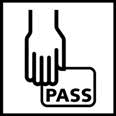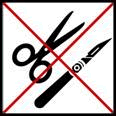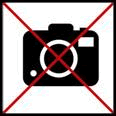3/07/2008
Encounters with the Iconic
When visiting the Duchamp, Man Ray, Picabia exhibition opening this week, it occurred to me that there is something mind-boggling about encountering an iconic work of art in the flesh. It is indeed flesh that we are referring to because the combination of paint, marble or any other material the artist might have used has become so familiar that it echoes the jolt of recognition usually associated to a friend's face. You feel that you know them if only for having read about them and for having seen reproductions.
But as I discovered when I came face to face with Duchamp's Nude Descending a Staircase, No. 2 and the Fountain signed R. Mutt, encounters with the seminal works are akin to bumping into a famous actor. There is first a sense of recognition that lingers as you stare at the individual. You recognize him yet you can't quite recall the details of this familiarity. Did you meet him at an opening or was it at your cousin's wedding? What's more, there is a slight sense of inadequacy in this recognition. You know this person, yet they should be taller, slimmer, younger. While all of these thoughts are racing through your mind, he will most likely have the time to walk right by you, not even glancing in your direction. The recognition is unrequited and you're left with the impression that you were snubbed in some obscure way.
The infamous Duchamp works credited for an irrevocable change in the production and understanding of art are quite recognizable, even in a room laden with other works by Man Ray and Picabia. They're familiar because such a cult has been built around them over the years that you've most likely encountered some version of them, and that might also be why the experience of actually seeing them leaves a bit to be desired. Is that urinal really what changed the course of history? Well, not exactly because the Fountain that you can see at Tate is actually a reproduction made in 1964 rather than the 1917 original and because it's not so much the object itself that has changed our understanding of art but rather the surrounding debates it generated.
So here you find yourself, in the presence of what looks like the famous actor without the costume, lighting, make-up and applause that contribute to elevate him above and beyond a mere human status, but it's in fact his stand-in. Where did the illusion go and why is the encounter so disappointing? Is that what Duchamp meant when he stated:
'The creative act is not performed by the artist alone; the spectator brings the work in contact with the external world by deciphering and interpreting its inner qualifications and thus adds his contribution to the creative act.'
Marcel Duchamp, from Session on the Creative Act, Convention of the American Federation of Arts, Houston, Texas, April 1957
Is art powerful only if we invest it with the knowledge of its history and with symbolic transformative powers? If, like myself, you have no answer to these questions, perhaps the Against the Avant-garde? Duchamp, Man Ray, Picabia study day on the 8th of March will be a good platform to discuss your beliefs or disbeliefs in the power of art. I will certainly try to challenge my visions of the not quite sublime encounters with the icons of the avant-garde.
This entry was first published on The Forum
Being Cadmium Red
Long gone are the days when I could get away with that kind of conduct in public with a gap toothed smile and a twirl of the pigtails. I am not even part of the ilk that is expected to disregard such petty considerations as socially acceptable conduct for the sake of art: the performance artist. My frenzy of non-verbal expression was legitimized by the context of the Physical Thinking course led by visual artist Liz Ellis and Suzy Willson, Artistic Director of the Clod Ensemble. They take it upon themselves to teach something simple, so simple in fact that we rarely ever think about it: movement. Liz and Suzy are offering a platform to question the fact that the way we move in galleries has very little to do with the way we are moved by the art we encounter. Actually, they skip the questions, the qualifications and the descriptions in favor of physical expression so the participants move, run, jump, crawl, twirl and leap their interpretation of art.
Chances are, you haven't had such an experience of the museum in a few decades yourself because this is just not usually behavior expected from your average museum audience. What's more, if we were all to launch in spontaneous arabesques in the middle of a crowded gallery, chances are some people might be left with the scarring experience of a crushed foot rather than the elating feeling of expression freed from analytical constraints. But, other than that, who's to say the physical response would be less valid than silent contemplation or a comparative analysis between the work and the information related in the exhibition catalog?
Although I spend most of my time doing the latter, I sometimes find that whatever I might read or say about a work doesn't come close to expressing all that I feel about it. So next time you see someone looking weighted down in front of a Judd or shimmying in front of a Vasarely, just know that it might be me, at a loss for words.
This entry was first published on The Forum
9/09/2006
Full responsibility
 Two – not one but TWO – works of art fell off the wall during the “Los Angeles 1955-85” Exhibition this Summer at the Centre Pompidou. On two separate occasions – yes, TWO. Don’t they know how to hammer a nail?
Two – not one but TWO – works of art fell off the wall during the “Los Angeles 1955-85” Exhibition this Summer at the Centre Pompidou. On two separate occasions – yes, TWO. Don’t they know how to hammer a nail?Well, apparently, an internal investigation was required in order to answer this question. Although I’ve never witnessed such an investigation, I would imagine that it entails Pompidou president Bruno Racine pointing at curators and art handlers and screaming “YOU, you must be the one to take the blame!” until somebody breaks down and cries.
In the first instance, it would appear that Bruno must have seen quite a few of his good people shed a tear before he obtained a full report. Indeed, the art handler blamed the restorer who blamed the person who then hung the piece who in turn blamed the restorer. Peter Alexander’s untitled 1971 piece is a vertical bar of resin nearly eight feet long. Some people would find it surprising that a big bar of resin should be hung on the Pompidou’s walls but that’s the subject of another discussion. “YOU, you must pay attention!” as Bruno would say.
So Peter Alexander’s untitled 1971 piece was about to be installed when art handlers noticed that a small metal ring inserted into the hanging hole was loose! Oh my! A restorer was immediately called in to glue the metal ring back on. Yes, some people are on-call for their knowledge of glue. She then instructed the people who were to hang the piece (I wonder if they’re called the hangers) to let the glue set for 24 hours. Well it would appear that some of her wisdom was “misinterpreted” because the work was hung that same day. It fell from the wall that very same night.
Now, of course, the Pompidou takes full responsibility, blaming the restorer who was an outside contractor. Bruno said, disapprovingly, that “It is clear the instructions should have been made in a written form.” Yes, had it been done by a glue specialist of the Pompidou, he would have known to make a little sign specifying “YOU, you must LET GLUE DRY FOR A FULL DAY!”
As for the mysterious incident of the falling Untitled Wall Relief of 1967 by Craig Kauffman, Bruno had to admit that his investigation was inconclusive. The convex bubble of acrylic-painted Plexiglas, whose upper edge slotted into a wall-mounted molding, just fell and broke after 130 days of apparently stable display. Then again, Bruno suspects that the hanging might have been flawed. You see, it was fabricated by the lender and its installation was overseen by an objects conservator that was not employed by the Pompidou. What’s more, according to Bruno, if the hanging was flawed, a visitor may have touched the work and dislodged it from its mount leading to its fall later.
Now that’s what I call taking full responsibility…
8/12/2006
It's for your own good



After the foiled terrorist attack on planes going from Britain to the U.S. on the 10th of August, taking a plane will never be the same… until we are distracted by something else and fall back on old habits.
Just a few days ago, I took a plane from Montreal to London with my laptop, two books, a gigantic bottle of water and an eyelash curler. One never knows when an eyelash curler might come in handy. The woman sitting next to me spent most of the flight guzzling a fluorescent sports drink and hugging a teddy bear big enough to take up half her seat. I tried not to pass judgment.
Had we traveled 24 hours later, we would have had a very different experience. After being stripped of shoes, belts and jackets to go through security, all that we could have brought on the plane would have been stuffed in a clear plastic bag allowing for easy screening and quick detection of teddy bears and eyelash curlers because the former can hide a multitude of weapons in its fuzzy belly. As for the latter, well, one never knows when it might come in handy... The restrictive list of the items we are allowed to fly with is now reduced to what could be called necessities:
- Pocket-sized wallets/ purses, plus contents (contents may not include explosives, weapons, any form of liquid, but I guess you can still have a bit of money)
- Passports/ travel tickets (might be a bit complicated to travel without them)
- Prescription medicines, not in liquid form unless verified as authentic (does the security personnel have to take a dose?)
- Essential medical items, eg diabetic kit (considering all these restrictions are apparently aimed at our safety, it was considered best to allow for a few bottles of insulin on board less these safety measures actually cause a passenger's death)
- Glasses & sunglasses, no cases (you might need them to see the films that will be screened to distract you from the fact that you couldn't even bring a book on board because you might have distracted the cabin crew with an impromptu dramatic reading)
- Contact lens holders, no solution (I'm sure Boots is on it's way to developing a dry storage solution but a bit of spit will have to do for now...)
- Baby food & milk for those with infants - bottle contents must be tasted by accompanying passenger (now is not the time for that brussel sprout flavored puree unless you really want to know why your child spits it out more than he swallows it)
- Essential sanitary items for infants (at least children are still allowed a minimum of comfort)
- Female sanitary items, unboxed (so everybody in the plane can know it's that time of the month)
- Tissues, unboxed, or handkerchiefs (because Keys, but no electric key fobs (are Tasers allowed if they're also key rings?)
Sure, it's a very short list considering all that we took for granted as essential to a comfortable flight just a few days ago, but that's nothing compared to the list of items allowed in the British Library's reading rooms: - No bag larger than 29x21x10cm may be taken into the Reading Rooms
- In addition to the above, no more than one clear plastic bag may be taken into the Reading Rooms, and, if required, a clear plastic bag for a lap top computer.
- You must comply with all requests for inspection: staff may open and inspect your personal possessions (including bags, sealed envelopes, folders, personal computers etc) as you enter and leave the Reading Rooms.
- You may not take outdoor coats into the Reading Rooms. Outdoor coats include overcoats, waterproof clothing of any length, outdoor jackets e.g. bomber, quilted, sheepskin, puffer, fleece and leather jackets etc. (This is not a place for fashion)
Items that could harm the collections are not allowed in the Reading Rooms. These include, but are not limited to: pens, food, drink, sweets (including cough sweets), chewing gum, glue, bottles of ink, correction fluid, cleaning liquids, scissors, knives (including craft knives and razor blades), highlighter pens, scanner pens, adhesive tape and umbrellas.
It's not clearly mentioned in these rules and regulations, but eyelash curlers are not allowed either. One never knows when a reader might be tempted to curl a few pages of a rare manuscript in a moment of boredom.
These rules are clearly aimed at the protection of the British Library's collection. It's your right not to respect them, but then you will not be granted access to the collection. In this case, responsibilities and rights are clearly spelled out: respect the rules, get access to the books.
But what are the responsibilities and rights implied by the new rules applied to air travel? We are told that these strictures are meant for our own security so we blindly accept them. Then again, we don't really have a choice if we need to take a flight, so we resort to rationales along the lines of "I don't like it but I'd rather go through that knowing that everybody has to do it which should insures my safety."
I agree that many systems cannot function without rules and regulations, some measure of control, but I start getting a tingly feeling of discomfort when the power to apply these rules is attributed to a rather conceptual entity (Airport Security? National Aviation Security Committee? Department for Transport? U.S. Government? British Government?) and when I'm told it's all for my own good. That's what parents tell their children when they don't want to eat their brussel sprout puree and can’t be bothered to explain why the dreaded green mush should be so beneficial...

